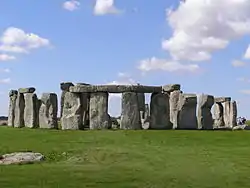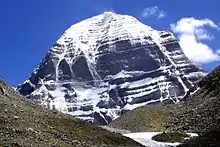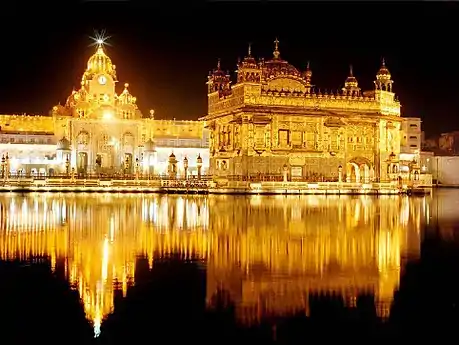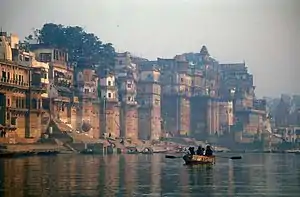Holy place
A holy place is a place that people consider holy and/or a religion considers to be of special religious significance. A holy place may be visited by visitors, known as pilgrims.
Baháʼí Faith
Located in Bahji near Acre, Israel, the Shrine of Bahá'u'lláh is the most holy place for followers of the Baháʼí Faith and their Qiblih, or direction of prayer. It contains the remains of Bahá'u'lláh, founder of the Baháʼí Faith and is near the spot where he died in the Mansion of Bahjí. The second holiest site is the Shrine of the Báb in Haifa.[1]
In Iran, the Baháʼís possessed several important holy sites, including the House of the Bab in Shiraz; the House of Baha' Allah's father in Tehran; the shrine and grave of Quddus. Since the Revolution, all these places have been demolished, and a mosque has been built on the site of the Bab's house.
Buddhism

The Buddha is said to have identified four sites most worthy of pilgrimage for Buddhists, saying that they would produce a feeling of spiritual urgency. These are:[2]
- Bodh Gaya, India, is the most important religious site and place of pilgrimage, the Mahabodhi Temple houses what is believed to be the Bodhi Tree where the Buddha realized enlightenment and Buddhahood.
- Kushinagar, India, is where the Buddha attained Parinirvana after his death.
- Lumbini, Nepal, is where Queen Maya gave birth to Prince Siddhartha Gautama.
- Sarnath, India, is the deer park where the Buddha first taught the Dhamma after realizing enlightenment.
In the later commentarial tradition, four more sites were added to make Eight Great Places, places where a miraculous event is reported to have occurred:
- Sravasti: Place of the Twin Miracle, showing his supernatural abilities in performance of miracles. Sravasti is also the place where Buddha spent the largest amount of time, being a major city in ancient India.
- Rajgir: Place of the subduing of Nalagiri, the angry elephant, through friendliness. Rajgir was another major city of ancient India.
- Sankassa: Place of the descending to earth from Tusita heaven (after a stay of 3 months teaching his mother the Abhidhamma).
- Vaishali: Place of receiving an offering of honey from a monkey. Vaishali was the capital of the Vajjian Republic of ancient India.
There are various other locations in India and Nepal associated with the Buddha, and there are holy sites located throughout Asia for each Buddhist tradition, for instance in Afghanistan, Cambodia, China, India, Indonesia, Japan, Laos, Myanmar, Nepal, Sri Lanka, South Korea and Thailand. Lhasa in Tibet contains many culturally significant Tibetan Buddhist sites such as the Potala Palace, Jokhang temple and Norbulingka palaces.
Christianity

.JPG.webp)
In Christianity, the primary holy places are significant because they are connected to the main events in the life of Jesus, the Saviour or Messiah to Christianity. Further, there are holy sites associated with events from the Old Testament, or with the lives of Mary, John the Baptist, and the Apostles, with endless more associated with later Christian saints, holy men and women, and local traditions.
The most important Christian holy sites are the place of Jesus' birth, the major ones of his ministry, and those of his crucifixion and resurrection:
- Jerusalem is believed to be the site of some of Jesus's teaching, the Last Supper, the subsequent institution of the Holy Eucharist as well as his entombment; Christians believe he was crucified on a nearby hill, Golgotha or Calvary. Jerusalem contains the Church of the Holy Sepulchre,[3] Via Dolorosa, Mount Zion, the Mount of Olives and the Garden of Gethsemane.
- Bethlehem is the birthplace of Jesus; see the Church of the Nativity
- Nazareth is Jesus's hometown and the scriptural place of the Annunciation, venerated at the Grotto of the Annunciation and the apocryphal site at Mary's Well
- The Jordan River, and specifically the traditional site of the Baptism of Jesus, known as Al-Maghtas on the East Bank in Jordan and extending onto the West Bank at Qasr al-Yahud
There is a wide range of places which have been proposed, forgotten, (re)discovered, etc., which are of different degrees of importance as holy, or pilgrimage sites, some based on local tradition, some recognised only by certain branches and sects of the Christian Church, some venerated only in a particular period, and some proposed by archaeologists. For those please see List of Christian holy places in the Holy Land.
Latter-Day Saints (Mormons)
- Sacred Grove, site of Joseph Smith's First Vision.
- Cumorah, burial site of the Book of Mormon.
- Adam-ondi-Ahman, the site where Adam will visit at the Second Coming.
Confucianism
Holy places of Confucianism include Temple of Confucius, Cemetery of Confucius and the Kong Family Mansion in Qufu, Shandong Province of China.
Druidism

Stonehenge is a site of religious significance in Neo-Druidism. Druids perform pilgrimage there, The first modern Druids to make ceremonies at this site is the Ancient Order of Druids.
Hinduism
The seven sacred ancient holy towns are Ayodhya, Mathura, Haridwar, Varanasi, Kanchipuram, Dvārakā, and Ujjain.
The Holy Dhamas (Char Dham to Smartas)
- Puri (East)
- Rameshwaram (South)
- Dvārakā (West)
- Badrinath (North)
The Four Maha Kumbha Mela sites
- Mathura/Vrindavana
- Dvaraka (Dwarka)
- Badrinath
- Puri (Jagannatha Puri)
- Tirupati
- Ayodhya
- Nathdwara
- Udupi

Kaumaram (Arupadaiveedu (Six sacred abodes of Murugan; Tamil
- Thiruthani Murugan Temple
- Swamimalai Murugan Temple
- Palani Murugan Temple
- Pazhamudircholai Murugan Temple
- Thirupparamkunram Murugan Temple
- Thiruchendur Murugan Temple
Shaktas (Shakti piths)
- Kanyakumari
- Madurai
- Vaishno Devi
- Calcutta (Kali Temple)
- Note that there are 51 principle Shakti sites throughout India
Tirth Kshetra
- Applies to only those places where pure natural water stream/river flows next to the temple, for example Kodlamane Shree Vishnumurthy Temple.
Islam
The three holiest sites in Islam are the Masjid al-Haram, or Grand Mosque, (in Mecca) ; the Al-Masjid al-Nabawi, or Prophet's Mosque, (in Medina) and Al-Aqsa Mosque in Jerusalem. Every year millions of Muslims from all over the world visit Masjid al-Haram and Al-Masjid al-Nabawi to perform Hajj.
Muslims are also required, if able, to undertake a pilgrimage to Mecca (Hajj) (/hædʒ/;[4] Arabic: حَجّ Ḥaǧǧ "pilgrimage") at least once in one's life:[5] The next two holiest sites especially for Shia Islam are the Imam Ali Mosque and the Imam Husayn shrine (which is visited by more pilgrims than any other holy site in any religion. More than 18 millions people visited on the day of Ashura in 2018)
Judaism

In Jewish tradition, the Temple Mount is regarded as the place where God chose the Divine Presence to rest. Jewish tradition regards the Mount, or the Foundation Stone, as the location of a number of important events mentioned in the Bible, including the location from which the world expanded into its present form, Abraham's binding of Isaac, Jacob's dream,[6] the threshing floor which King David purchased from Araunah the Jebusite,[7] and the location of the two Jewish Temples. Jewish texts record that the Mount will be the site of the Third Temple, which will be rebuilt with the coming of the messiah.
The Temple Mount is the holiest site in Judaism and is the place to which Jews turn during prayer. Due to its extreme sanctity, many Jews will not walk on the Mount itself, to avoid unintentionally entering the area where the Holy of Holies stood. The Temple is mentioned extensively in Orthodox services. Conservative Judaism mentions the Temple and its restoration, but not its sacrifices. The destruction of the Temple is mourned on the Jewish fast day of Tisha B'Av, and is remembered on a number of occasions such as in the breaking of a glass at the end of a wedding ceremony. Due to religious restrictions on entering the most sacred areas of the Temple Mount (see following section), the Western Wall, a retaining wall of the Temple Mount and remnant of the Second Temple structure, is considered by some rabbinical authorities the holiest accessible site for Jews to pray.
Jerusalem itself is also the holiest city in Judaism, and the spiritual center of the Jewish people since the 10th century BCE.[8] The Four Holy Cities in Jewish tradition are the cities of Jerusalem, Hebron, Tiberias, and Safed: The Jewish Encyclopedia in 1906 noted: "Since the sixteenth century the Holiness of Palestine, especially for burial, has been almost wholly transferred to four cities—Jerusalem, Hebron, Tiberias, and Safed."[9]
Sikhism

The Panj Takht are the five gurudwaras which are revered as the seats of power in Sikhism. They are all located in India - the Akal Takht Sahib in Amritsar, Punjab; the Keshgarh Sahib in Anandpur Sahib, Punjab; the Damdama Sahib in Bhatinda, Punjab; the Takht Sri Patna Sahib in Patna, Bihar and the Hazur Sahib Nanded in Nanded, Maharashtra.
Sri Harmandir Sahib, also known as Sri Darbar Sahib or Golden Temple, (on account of its scenic beauty and golden coating for English speaking world), is named after Hari (God) the temple of God. The Sikhs all over the world, daily wish to pay visit to Sri Amritsar and to pay obeisance at Sri Harmandir Sahib in their Ardas.
Guru Arjan's father Guru Ram Das founded the town named after him "Ramdaspur", around a large man-made water pool called "Ramdas Sarovar". Guru Arjan continued the infrastructure building effort of his father. The town expanded during the time of Guru Arjan, financed by donations and constructed by voluntary work. The pool area grew into a temple complex with the gurdwara Harmandir Sahib near the pool. Guru Arjan installed the scripture of Sikhism inside the new temple in 1604.[10] The city that emerged is now known as Amritsar, and is the holiest pilgrimage site in Sikhism.[10][11]
Taoism
Four sacred mountains of Taoism:
- Wudang Mountains, in Shiyan, Hubei Province of China;
- Mount Qingcheng, in Dujiangyan, Sichuan Province;
- Mount Longhu, in Yingtan, Jiangxi Province;
- Mount Qiyun, in Huangshan, Anhui Province.
See also
References
- "Holy Places of the World". adherents.com.
- The Buddha mentions these four pilgrimage sites in the Mahaparinibbana Sutta. See, for instance, Thanissaro (1998) and Vajira & Story (1998).
- "A Video Tour inside the church of the Holy Sepulchre".
- "Hajj". Random House Webster's Unabridged Dictionary.
- Juan Eduardo Campo (2009). Encyclopedia of Islam. Infobase Publishing. p. 281. ISBN 978-1-4381-2696-8.
- Toledot 25:21
- 2 Samuel 24:18–25
- Why Do Jews Love Jerusalem? by Yeruchem Eilfort. Chabad.org/ Ideas & Beliefs/Questions & Answers/Mitzvot & Jewish Customs
- Palestine, Holiness Of by Joseph Jacobs, Judah David Eisenstein. Jewish Encyclopedia, 1906 ed.
- Christopher Shackle; Arvind Mandair (2013). Teachings of the Sikh Gurus: Selections from the Sikh Scriptures. Routledge. pp. xv–xvi. ISBN 978-1-136-45101-0.
- W.H. McLeod (1990). Textual Sources for the Study of Sikhism. University of Chicago Press. pp. 28–29. ISBN 978-0-226-56085-4.
External links
- A Journey Through the Holy Lands (Photo Gallery) IslamOnline.net

